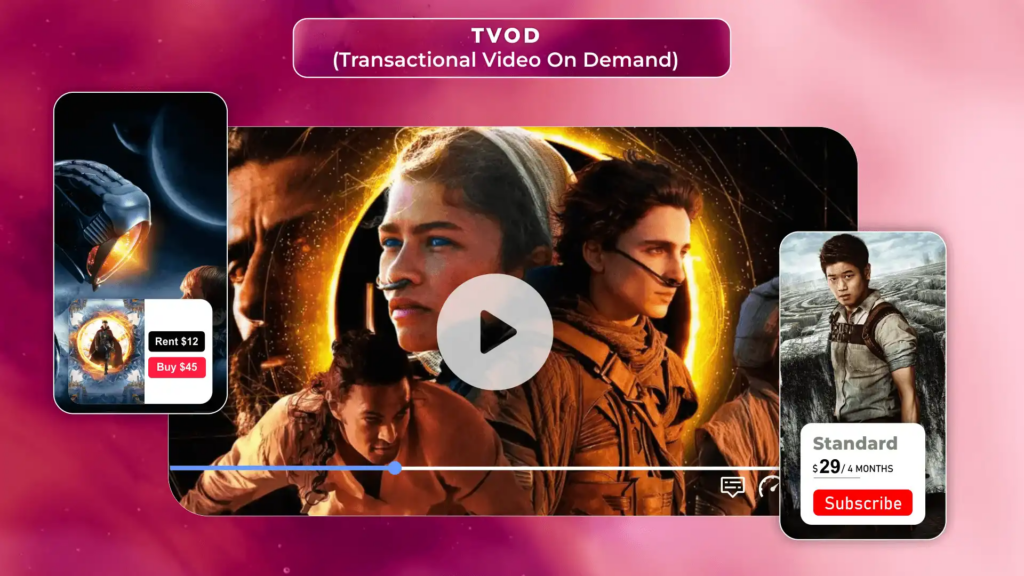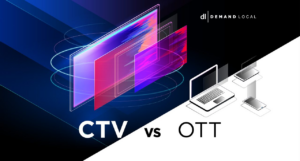The massive growth of streaming video has led to more choice and flexibility in how viewers access and pay for content. One model that has gained traction is transactional video-on-demand, or TVOD.
TVOD services allow consumers to pay a one-time fee to immediately rent or buy digital access to movies, TV shows, and other videos.
This contrasts with subscription video-on-demand (SVOD) like Netflix where you pay a recurring monthly fee.
In this article, we’ll explore what exactly TVOD is, how it works, the different pricing options, major providers, how it compares with other streaming models, and the outlook for TVOD growth.
For viewers looking for more flexibility in streaming purchases without ongoing subscriptions, TVOD presents an appealing approach to accessing content.

What is TVOD?
TVOD stands for “transactional video-on-demand.” It is an online streaming model where users pay a one-time fee to access individual pieces of content.
This transactional model is different than subscription streaming services like Netflix or Hulu where you pay a flat recurring monthly rate.
With TVOD, pricing is on a per-title basis. Consumers can digitally rent or buy movies, TV show episodes, sports events, concert videos, and other content.
Pricing depends on the newness and popularity of the title. There are no contracts involved – you simply pay for what you want to watch when you want it.
Some defining features of TVOD services include:
- Pay per title, no ongoing subscription
- Option to buy or rent content
- New release movies and TV shows
- Large catalog of older library content
- Premium video quality – HD, 4K, HDR
- Accessible across many devices
- No long-term commitments
This pay-as-you-go approach gives consumers more choice in how they access and pay for premium streaming content.
How TVOD Streaming Works
With transactional VOD services, users can buy or rent movies, TV shows, and other videos:
- Search an online storefront to find a title to watch
- Select their preferred purchase or rental price option
- Complete the transaction by paying the fee electronically
- Access is instantly granted to stream the video within the allotted rental timeframe
- Downloads are also offered for offline viewing on mobile devices
Leading TVOD platforms include Apple iTunes, Google Play Movies & TV, Microsoft Store, Vudu, YouTube Movies, Amazon Instant Video, and FandangoNOW.
Major cable providers also enable TVOD purchases that appear directly on the monthly bill.
TVOD is more flexible than old rental stores since it delivers media digitally without needing to physically visit a location.

Purchase vs. Rental Options
TVOD services offer both purchase and rental choices when acquiring video content:
Purchase
- Permanently owns a digital copy of the video
- Can be watched repeatedly anytime
- Usually costs $5-$20 per title depending on quality and newness
Rental
- Temporary access for a limited duration, usually 24-48 hours
- Expires after the viewing window ends
- Discourages indefinite access for one low-price
- Rentals typically cost $1-$5 per video
Purchases appeal to frequent re-watchers, while rentals suit those only planning to view once. Some platforms allow upgrading a rental to a purchase if viewers change their minds later.
Benefits of TVOD Streaming
Some benefits that make transactional VOD services still appealing include:
- No subscriptions – Pay only for the titles you truly want to watch rather than monthly fees.
- Latest releases – New movies are frequently available the same day as DVD or digital sell-through releases.
- Flexibility – Pick a rental or purchase option on a case-by-case basis.
- Ownership – Purchased movies can be added to permanent digital collections.
- Discounts – Frequent sales and specials lower prices of purchases and rentals.
- Instant access – Start watching shortly after paying rather than waiting for delivery.
- Feature focus – The transactional model incentivizes the availability of more new feature-length films.
- Anytime expiry – Rental access windows allow starting playback at the user’s convenience.
- Device reach – Ability to access purchased or rented content across various devices.
Drawbacks of TVOD
However, the transactional model also comes with some downsides:
- Higher overall cost – A la carte purchases add up fast compared to a flat monthly unlimited streaming fee.
- No binge-watching – Renting titles one by one is costlier for serialized binging.
- Limited selection – Far smaller catalogs than subscription service libraries. Mostly newer mainstream releases.
- Rental windows – Short rental expiration windows can feel restrictive for multi-session viewers.
- No refunds – Purchases and rentals are non-refundable, even if you dislike the content.
- Split libraries – Titles scattered across multiple retailer catalogs rather than one centralized service.
- Max quality – Video resolution and sound quality top out at HD quality levels. Lacks 4K or Dolby Atmos support.
- Device restrictions – Purchased or rented content cannot always be accessed on every type of streaming box or smart TV platform due to DRM restrictions.
- Price fluctuations – Sale discounts come and go frequently, creating pricing uncertainty.

Comparing TVOD to SVOD
Since TVOD competes with subscription streaming, it’s useful to contrast some key differences between the transactional and SVOD models:
- Content – SVOD has bigger libraries. TVOD focuses on newer releases.
- Price – SVOD has a flat monthly fee for unlimited access. TVOD charges per each title transaction.
- Ownership – TVOD allows permanent digital ownership of purchased titles. SVOD only provides access during the subscription.
- Releases – Major new movies are available on TVOD and SVOD day and date. TVOD tends to get catalog content later.
- Curation – TVOD libraries are less curated than SVOD with lots of catalogue filler content.
- Device support – TVOD has more restrictive DRM and platform support. SVOD apps are widely available.
- Video quality – SVOD leads in 4K, HDR, and Dolby Atmos support. TVOD tops out at HD.
- Rights – SVOD licenses rights for set periods exclusively. TVOD licenses non-exclusively from studios.
- Availability – TVOD offers the latest releases widely. SVOD availability varies by region.
- Bingeing – SVOD is better for binge-watching with full series access. TVOD is more discrete and title-focused.
TVOD Industry Trends
Some current trends shaping the transactional streaming landscape include declining purchases and rentals as subscription streaming grows in popularity. Periodic discounts and promotions continue driving transactional sales.
There has been an expanded selection of TV series purchases and rentals alongside movies. New release movies are available quicker after theatrical release to stay competitive.
4K Ultra HD quality is supported on select premium purchases. Technology partnerships are improving cross-platform viewing capability. Bundles like Amazon Prime bolster retail loyalty and digital transactions.
Merchandising complementary products like soundtrack downloads on video purchase pages provides additional value.
Social features display recent purchases and rentals among friend networks. Increased studio revenue comes from electronic sell-through (EST) purchases compared to physical sales.
TVOD stores are integrating directly into smart TV interfaces rather than external streaming boxes. Free premiere episodes of seasons are marketed alongside later episodes for individual purchase.
The Future of Transactional Streaming
Some possible directions for the evolution of TVOD services are Closer retail integration like video purchases directly triggering product delivery for physical/digital bundling;
Social shopping features like gifting video purchases, shared viewing parties after coordinated buys; Dynamic differential pricing for purchases based on individual willingness to pay data;
TVOD fulfilling niche of providing individual episode access from current seasons of active series; Enabling transactional rentals or purchases within subscription streaming apps as added monetization;
Streaming boxes or smart TVs that only offer curated TVOD stores rather than full-fledged subscription platforms; AI algorithms matching viewers with niche content then motivating predicted purchase/rental conversions;
Blockchain to secure digital ownership rights, transfers, and cross-platform viewing of purchased titles; TVOD stores building subscriber bases through discounted bundled rentals rather than pure a la carte pricing;
Offering layering of supplemental commentary tracks, extended edits and bonus materials on movie purchases.
While pressured, purpose-driven transactions for specific programming will likely continue to serve a segment of consumer viewing habits not fully satisfied by subscription libraries.

Frequently Asked Questions (FAQ)
Q1. What are the main transactional VOD services?
Ans. Top TVOD platforms include Apple iTunes, Google Play Movies & TV, Amazon Instant Video, Microsoft Store, Vudu, YouTube Movies, FandangoNOW, and cable or satellite provider VOD stores.
Q2. How long do TVOD rentals last?
Ans. Rental access windows vary by provider but commonly last either 24 or 48 hours from when playback is first initiated. Some platforms allow pausing the window if not finished watching within that timeframe.
Q3. Can I return a purchased movie on VOD services?
Ans. Purchases are non-refundable. However, many services offer preview periods or guarantees on select titles. Policies, eligibility, and preview lengths depend on the specific retailer.
Q4. Why do rentals cost less than buying?
Ans. Lower rental fees reflect the limited access window. A rental may only be watched once or twice, while purchases confer unlimited repeat viewing rights.
Q5. Is it better to rent or buy TV episodes?
Ans. If you want to watch a whole season, a streaming subscription is often cheaper than individually buying episodes. Renting makes sense for catching up on a few missed episodes of a current season airing weekly.




